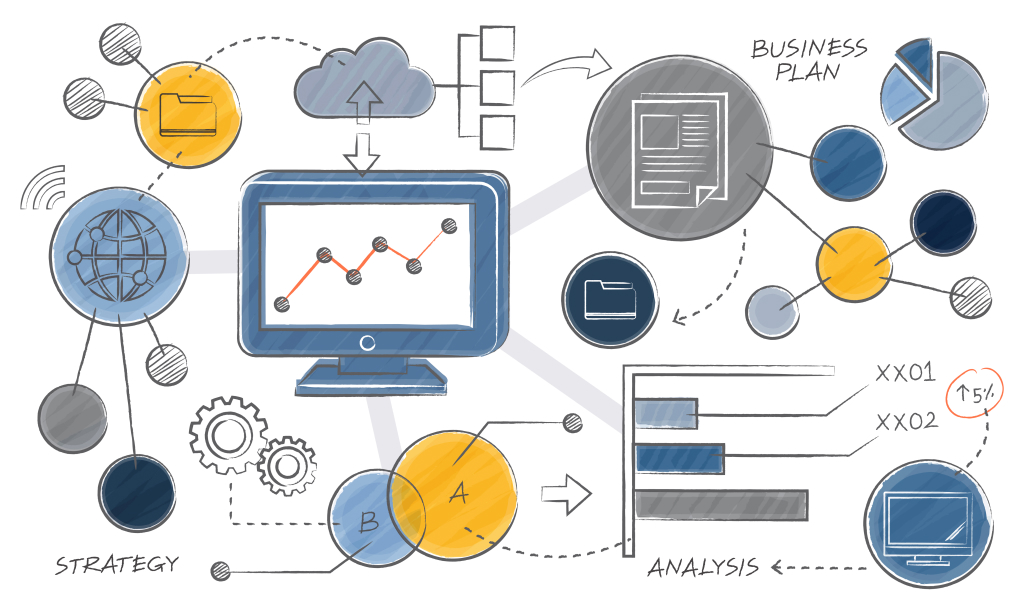
The Role of Data Analytics in Business Decision Making
Defining Data Analytics
Data analytics, in its essence, is the process of sifting through vast mountains of raw data to unearth actionable conclusions and insights. Over the past few decades, the evolution of analytics has progressively become a cornerstone of modern business operations. It extends beyond mere number-crunching, acting as a lens that provides a sharper focus on what the data is really conveying about a business's performance and potential.
The Rise of Data-Driven
Decisions in Modern Business The contemporary business world thrives on information. And not just any information, but verifiable, actionable data that can steer decisions in the right direction. This shift to data-driven strategies has made businesses more adaptable, resilient, and proactive. The importance of data in business, enriched by analytical insights and sophisticated business data processing, forms the bedrock upon which companies are building their future.
The Relationship between
Data Analytics and Business Decision Making Picture a world where businesses operated on mere hunches or educated guesses. The pitfalls would be numerous, right? With data analytics, businesses now wield the power to make decisions based on past patterns, current trends, and future predictions. In this symbiotic relationship, analytics feeds into decision-making processes, ensuring that every move made is backed by robust data intelligence.
The Pillars of Data Analytics in Business
Business Intelligence: Translating Data into Insights
Business Intelligence (BI) goes beyond mere data collection. It delves deep into the data realm, utilizing advanced analytics tools and sophisticated big data platforms to transform raw, often chaotic data into structured, meaningful insights. In an age where information overload is common, BI tools help businesses distill the essence, facilitating strategic movements.
Predictive Analytics: Forecasting Business Trends and Outcomes
The power to foresee business trends is invaluable. Predictive analytics, driven by data extraction techniques, offers precisely that. By analyzing past data and recognizing patterns, it provides businesses with a roadmap of potential future scenarios. This foresight enables them to strategize, prepare, and act with precision, staying one step ahead of the curve.
Decision Support Systems: Facilitating Informed Choices
Decision-making in businesses, especially large corporations, can be labyrinthine. Decision Support Systems (DSS), fortified by intricate analytical models, act as navigational aids. They not only present data but also model potential outcomes based on varying scenarios, providing businesses a holistic view of potential repercussions and benefits of their choices.

Tools and Technologies Powering Data Analytics
Big Data: The Underlying Foundation
The term 'Big Data' does justice to its name. It’s colossal, diverse, and is generated at lightning speed. But it's not about the volume alone; it's about the insights locked within. Big data platforms, equipped to handle this magnitude and complexity, extract the essence, turning sheer volume into an asset.
Data Mining: Extracting Patterns and Information
At the crossroads of technology and detective work lies data mining. By rummaging through vast datasets, data mining techniques spotlight hidden patterns, correlations, and potential opportunities that might have otherwise remained obscured. It's like finding needles of insights in haystacks of data.
Data Visualization: Representing Data in Understandable Formats
Data, in its raw form, can be overwhelming. Through data visualization tools, these massive datasets are transformed into visual stories, making interpretation intuitive. Charts, heat maps, and interactive dashboards not only simplify the complex but also engage stakeholders in meaningful dialogues.
Advanced Analytics in Business
Real-time Analytics: Making Decisions in the Moment
The business world doesn't pause. Every split second, data is generated, and with real-time analytics, businesses can react to this data instantaneously. Be it a sudden market shift or an unforeseen crisis, real-time insights empower businesses to pivot with agility.
Machine Learning in Business: Automating Analytical Model
Building Machine learning is rewriting the playbook for businesses. Instead of relying on static models, businesses now harness algorithms that learn and evolve. This continuous learning process, underpinned by automated predictive model building, refines strategies, making them more effective over time.
KPI (Key Performance Indicator): Measuring Success
In the vast ocean of data, KPIs are the lighthouses. These predefined metrics, integral key metrics in analytics, provide clear indications of a business's performance against its set objectives. They highlight successes, reveal shortcomings, and pave the way for strategic recalibrations.

The Positive Impact of Data Analytics
Strategic Decision Making: Guiding the Business Path
Strategy, when underpinned by data, transforms from a theoretical approach to a precision-guided pathway. By integrating data-driven strategy, businesses ensure that every tactical move aligns with larger objectives, ensuring differentiation in crowded market spaces.
Achieving Competitive Advantage: Standing Out in the Market
In a world where businesses often offer similar products or services, the value of data insights can be a game-changer. By understanding customer behaviors, market shifts, and industry trends in granular detail, businesses can sculpt unique propositions, elevating their standing in the market.
ROI (Return on Investment) from Analytics: Quantifying the Value
Investments are made with returns in mind. When it comes to analytics, the ROI isn't just financial; it's also strategic. The tangible and intangible benefits, or the data-driven benefits, range from increased profits to stronger brand positioning, justifying every penny invested in analytics tools and expertise.
Practical Considerations in Data Analysis
Quantitative Analysis: The Role of Numbers in Decision Making
While gut feelings and instincts have their place, the irrefutable logic of numbers often holds the trump card. Quantitative analysis, empowered by robust statistical methods in business, offers a balanced, objective foundation for critical business decisions.
Benefits of Data Analytics: From Efficiency to Profitability
The ripple effect of data analytics is vast. On the surface, it offers clarity, but dive deeper, and its benefits span from operational efficiency to profitability. By optimizing processes, targeting the right audience, and preempting market shifts, businesses can carve out a trajectory of sustained growth.
Challenges in Data Analysis: Obstacles and Solutions
No journey is without hurdles, and in the realm of data analytics, challenges abound. Data integrity issues, siloed data structures, and the ever-present threat of data breaches are but a few. However, with a proactive approach, fortified by the right tools and expertise, these challenges aren't insurmountable.
Conclusion
Image suggestion: A digital horizon, seamlessly merging with the physical world, symbolizing the symbiosis of data and tangible business outcomes.
The Future of Business Decision Making and Data Analytics
The tapestry of business's future is interwoven with threads of data. As AI becomes ubiquitous and real-time insights become the norm, businesses that adapt, imbibe, and integrate these future analytics trends will be the frontrunners in their respective domains.
Embracing a Data-Driven Culture for Sustainable Growth
Beyond the tools, technologies, and techniques, there's a mindset shift. To truly harness the power of data, businesses must cultivate a data-centric culture. This ethos, when ingrained in every facet of an organization, from top leadership to grassroots levels, paves the way for holistic, sustainable growth.
References
- Thompson, A.L. & Rutherford, J.H. (2019). Data-Driven Business: The Analytics Revolution in Modern Corporations. Harvard Business Review Press.
- Patel, S. & Wang, Z. (2020). Predictive Analytics and Business Forecasting: The Modern Toolkit. Journal of Business Intelligence and Data Analysis, 14(3), 211-229.
- Moreno, L.V. (2018). Challenges in Data Analysis: Overcoming Business Analytics Roadblocks. Wiley Business Series.
 Mark Petrenko
Mark Petrenko 
